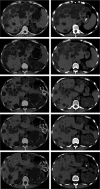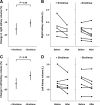Sirolimus reduces polycystic liver volume in ADPKD patients
- PMID: 18199797
- PMCID: PMC2391057
- DOI: 10.1681/ASN.2007050626
Sirolimus reduces polycystic liver volume in ADPKD patients
Abstract
The immunosuppressive agent sirolimus exerts an antiproliferative effect by inhibiting mammalian target of rapamycin (mTOR). Because excessive proliferation of the biliary epithelium is a prominent feature of the polycystic liver that accompanies autosomal dominant polycystic kidney disease (ADPKD), we hypothesized that sirolimus may benefit patients with this disorder. We retrospectively measured the volumes of polycystic livers and kidneys in ADPKD patients who had received kidney transplants and had participated in a prospective randomized trial that compared a sirolimus-containing immunosuppression regimen to a tacrolimus-containing regimen. Sixteen subjects (seven with sirolimus, nine with tacrolimus) had received abdominal imaging studies within 11 mo before and at least 7 mo after transplantation, making them suitable for our analysis. Treatment with the sirolimus regimen for an average of 19.4 mo was associated with an 11.9 +/- 0.03% reduction in polycystic liver volume, whereas treatment with tacrolimus for a comparable duration was associated with a 14.1 +/- 0.09% increase. A trend toward a greater reduction in native kidney volume was also noted in the sirolimus group compared with the nonsirolimus group. Regarding mechanism, the epithelium that lines hepatic cysts exhibited markedly higher levels of phospho-AKT, phospho-ERK, phospho-mTOR, and the downstream effector phospho-S6rp compared with control biliary epithelium. In summary, treatment with sirolimus was associated with decreased polycystic liver volume, perhaps by preventing aberrant activation of mTOR in epithelial cells lining the cysts.
Figures






References
-
- Bae KT, Zhu F, Chapman AB, Torres VE, Grantham JJ, Guay-Woodford LM, Baumgarten DA, King BF Jr, Wetzel LH, Kenney PJ, Brummer ME, Bennett WM, Klahr S, Meyers CM, Zhang X, Thompson PA, Miller JP: Magnetic resonance imaging evaluation of hepatic cysts in early autosomal-dominant polycystic kidney disease: The Consortium for Radiologic Imaging Studies of Polycystic Kidney Disease cohort. Clin J Am Soc Nephrol 1: 64–69, 2006 - PubMed
-
- Chauveau D, Fakhouri F, Grunfeld JP: Liver involvement in autosomal-dominant polycystic kidney disease: Therapeutic dilemma. J Am Soc Nephrol 11: 1767–1775, 2000 - PubMed
-
- Torres VE, Harris PC: Mechanisms of disease: Autosomal dominant and recessive polycystic kidney diseases. Nat Clin Pract Nephrol 2: 40–55; quiz 55, 2006 - PubMed
-
- Bhunia AK, Piontek K, Boletta A, Liu L, Qian F, Xu PN, Germino FJ, Germino GG: PKD1 induces p21(waf1) and regulation of the cell cycle via direct activation of the JAK-STAT signaling pathway in a process requiring PKD2. Cell 109: 157–168, 2002 - PubMed
-
- Yamaguchi T, Nagao S, Wallace DP, Belibi FA, Cowley BD, Pelling JC, Grantham JJ: Cyclic AMP activates B-Raf and ERK in cyst epithelial cells from autosomal-dominant polycystic kidneys. Kidney Int 63: 1983–1994, 2003 - PubMed
Publication types
MeSH terms
Substances
Grants and funding
LinkOut - more resources
Full Text Sources
Other Literature Sources
Medical
Miscellaneous

